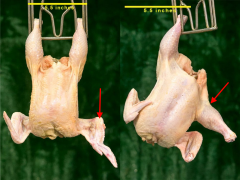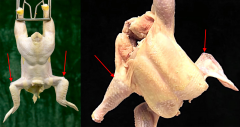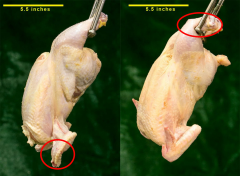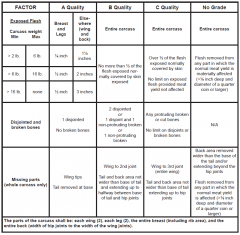Market Poultry - Grading ready-to-cook carcasses
Ready-to-cook (RTC) carcass grade scoring is based on the USDA quality grades A, B, and C. No Grade (NG) is an option only if the carcass has a major defect that exceeds meat removal that is allowed for a C grade. Factors used in judging ready-to-cook carcasses and parts in a 4-H Poultry Judging Contest are:
- Exposed Flesh
- Missing Parts
- Disjointed and Broken Bones
Always select your score based on the lowest grade defect found on each carcass or part.
Because of the length of most judging contests, carcasses will dry out. You should not grade carcasses based on off-color areas that appear bruised, dried out, or discolored. In addition, feathers and pin-feathers are not used as a quality factor when carcass grading.
Carcasses used for contests will usually have Grade A fleshing, conformation, and fat cover. You should, however, be prepared to recognize poor fleshing and finish if such carcasses are available for a contest.
The carcasses you judge will be hanging from shackles. This method is used to make it easier to see all parts of the carcass. Carcasses cannot be touched or handled during judging events. It is permissible to turn the shackle to see the entire carcass as long as you do not touch the carcass. You can also tilt the shackle to check for broken bones. The carcasses can be hung from both legs, or just one (see Figure 1). If you do not have shackles for practicing and the ready-to-cook carcasses are placed on plates, judge the carcasses based on what you can see.
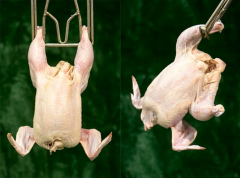
Ready-to-cook carcasses will be judged according to the quality specifications in Table 1. Table 1 includes three weight categories for determining the size of exposed flesh on the different parts of the whole carcasses. In a 4-H poultry judging contest, however, only the first two weight classes will be used. There are no weight ranges for missing parts, disjointed, and/or broken bones.
Learn a method of judging carcasses by looking at one part at a time. By definition, the six parts of the carcass are; each wing (2), each leg (2), the entire breast (including the rib area), and the entire back (width of the hip joints to the width of the wing joints).
Table 1. Summary of USDA Specifications for Standards of Quality for Individual Whole Carcasses (click on the image to enlarge).
1. EXPOSED FLESH
Cuts, tears, and trims are a result of a mis-cut or tearing of the skin during a processing operation. When ready-to-cook carcasses are downgraded for cuts, tears, and trims, it is based on the amount of exposed flesh, weight of the carcass, and the part where the exposed flesh occurs. The length of a cut or the amount of flesh showing on the part determines the grade. Cuts, tears, or trims must be completely through the skin so that the meat, called flesh, can be seen before putting the carcass in a lower grade.
Injection marination is a common practice for many poultry processors. Marination injection marks should not be considered if they appear on carcasses and parts within a contest. The presence of the marks will be announced by the contest officials during the contest orientation.
The grade is determined by the amount of exposed flesh as the length of the cut or amount of skin missing (Table 1). Sometimes a carcass or part may have more than one cut, tear, or trim. When there is more than one exposed area on a particular part, add the length or amount missing to determine the grade based on that part only. Cuts and tears in the flesh are cumulative on a given individual part, but they are NOT cumulative across multiple parts. Each part is graded separately and the grade is determined by the part having the lowest grade on the carcass.
Figure 2 shows some typical cuts and tears resulting in missing skin (or exposed flesh) on the breast of 2-6 lb. carcasses. The Grade A carcass is permitted to have only cuts or tears on the breast that total less than 1/4 inch and no missing skin. The Grade B carcass can have up to 1/3 of the flesh on the entire breast exposed. The Grade C carcass has more than 1/3 of the flesh exposed on the entire breast.
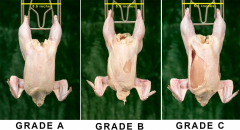
Figure 3 shows deep cuts on various parts of a carcass that remain Grade B based on the amount of exposed flesh. Cuts on the carcass that are deeper than 1/8 inch without any meat removal will not change the grade beyond what is designated for the exposed flesh.
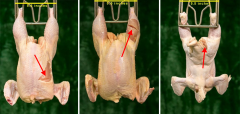
A trim is when meat is removed. Trims that do not exceed 1/8 inch in thickness (approximately the thickness of a nickel coin) and the area of 0.75 inches in diameter (approximately the size of a quarter coin) do not affect the grade. Any time meat is removed from the breast and legs of the carcass that exceeds these parameters, the carcass would be marked as a NO GRADE. Figure 4 shows trims on carcasses where the meat yield is affected.
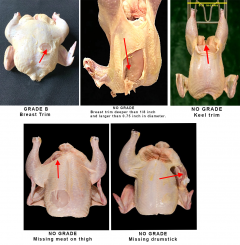
Parts such as wings and the back portion (considered 'elsewhere') on a 2-6 lb. carcass can have a cut or tear up to 1½ inches for a Grade A carcass. Grade B carcasses are allowed to have up to 1/3 of the flesh exposed. Any part with more than 1/3 flesh exposed on the entire part is a Grade C carcass. Length, such as that from a knife cut, is as important as the width that is a result of a tear in determining carcass grade. Figure 5 shows examples of back and wing cuts with the corresponding grade.
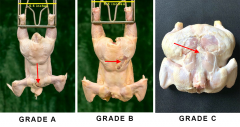
Refer to Table 1 for the section on cuts and tears for the lengths and amount of exposed flesh that is allowed. If a cut is less than 1½ inches in the wing of a 2-6 lb. carcass (Grade A) and also cuts into the meat more than 1/8 inch or the trim appreciably alters the appearance, the carcass should still be graded by the size of the exposed flesh since it is a part that can be removed.
Processing cuts near the vent and/or breast opening less than 1-inch beyond the opening are acceptable and should not be considered in grading the carcass. If a processing cut is larger than 1-inch, as demonstrated in Figure 6, downgrade the carcass to a Grade B.
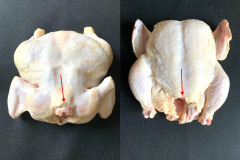
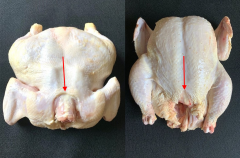
2. MISSING PARTS
Missing parts to be considered in judging are the wings, tail, and back. Carcass weight is not a factor when judging for missing parts.
Use the lowest grade that you see for the wings, tail, and back that may be missing. Any part, or flesh missing from anywhere else, and the carcass will be considered a NO GRADE. The NO GRADE designation implies a loss of marketable product and is intended for excessive trim beyond what is designated for the A, B, or C grades (allowable loss of wings and back areas). Excessive trim of a wing into the breast muscle, or tail trim wider/deeper than that which is allowed for a Grade C, would result in a NO GRADE designation. For example, if significant meat (deeper than 1/8 inch and larger than 0.75 inches in diameter) is missing from the breast as the result of an excessive wing removal, or the tail is cut wider than the base of the tail or is cut beyond the hip joints, the carcass should be considered a NO GRADE.
A Grade A carcass can have one or both of the wing tips removed. The Grade B carcass would be missing one or both of the wings to the second joint. A Grade C carcass will have one or both whole wings cut off cleanly at the juncture of the body without removing breast meat. A NO GRADE carcass has breast meat trimmed with the removal of the whole wing. See Figure 7 for different examples.
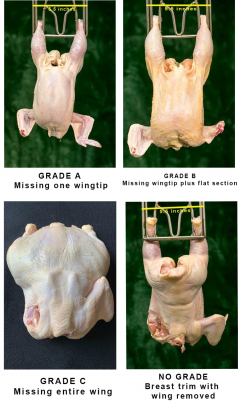
A photo showing the anatomical reference points for the tail and back is found in Figure 8a. Figure 8b shows examples of carcass grades based on tail and back removal. The Grade A carcass has the tail removed at its base. For the Grade B carcass, the back area, not wider than the tail's base and halfway to the hip joint is removed. The Grade C carcass has the back area removed not wider than the tail's base and extended beyond the hip joints. The NO GRADE carcass has been trimmed wider than the base of the tail resulting in meat loss.
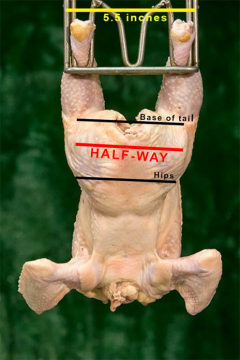

3. DISJOINTED AND BROKEN BONES
A disjointed bone is where the ball end portion of a joint is out of the socket. In other words, the part that is disjointed is still whole and not broken. You may be able to see the end or ball portion of the joint underneath the skin.
Broken bones occur between the two ends of a bone and are typically not associated with a joint. They can be broken such that the bone either does or does not come through the skin. When the broken bone does not come through the skin it is called non-protruding. When the broken bone ruptures through the skin, it is referred to as a protruding bone. The wing tips will not be considered for disjointed or broken bones.
As listed in Table 1, a Grade A carcass can have one disjointed, but no broken bones. A Grade B carcass can have either two disjointed bones or one disjointed and one non-protruding broken bone. If the broken bone is in the wing mid-joint it is considered one broken bone even though there are two bones present. More than two disjointed or non-protruding broken bones, or any protruding broken bones, would make the carcass a Grade C. Figure 9 shows some examples of broken and disjointed bones that you may see on carcasses.
